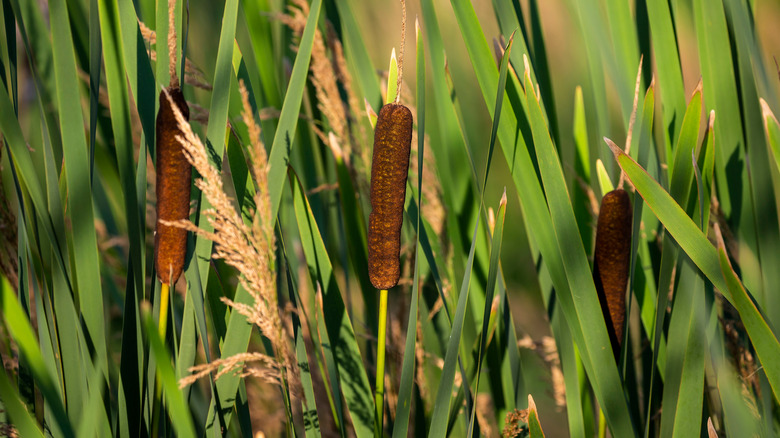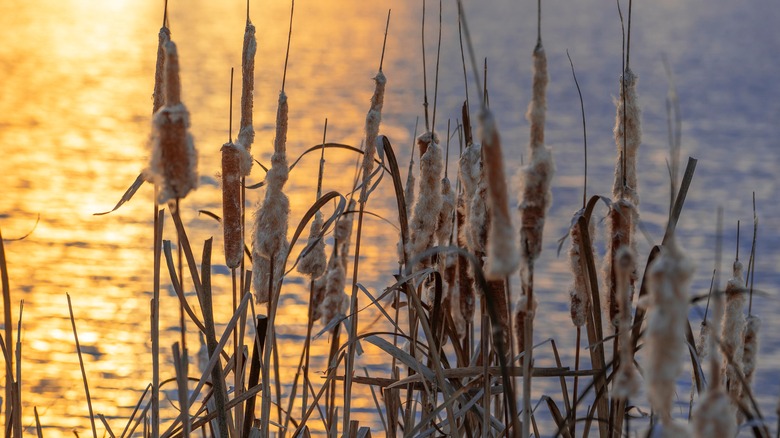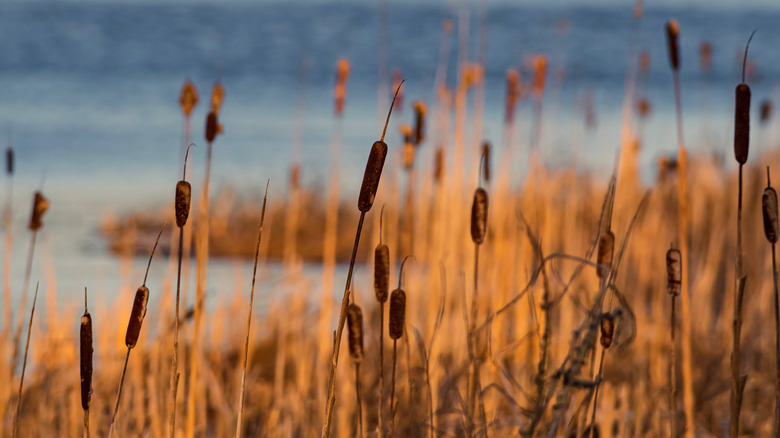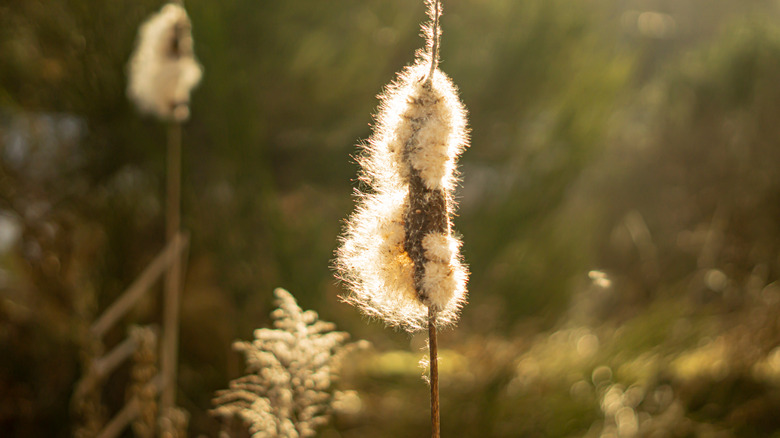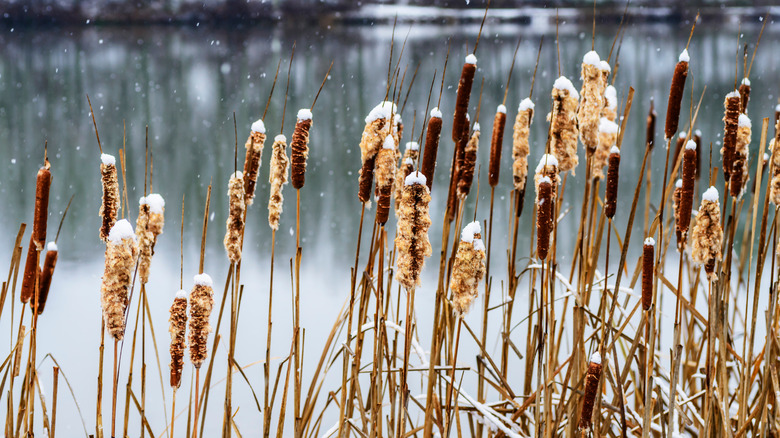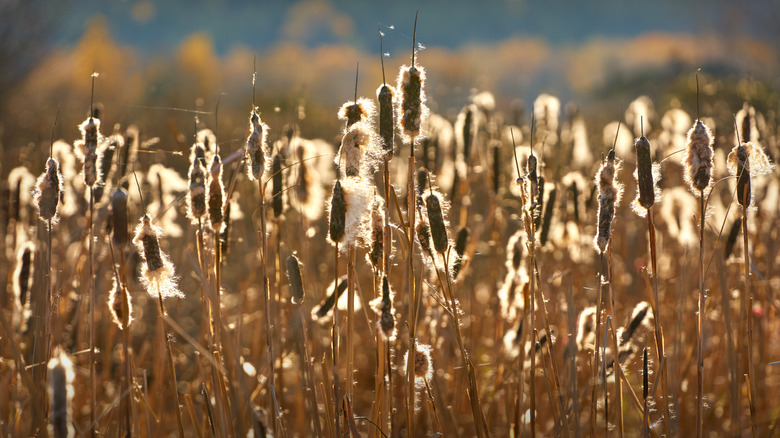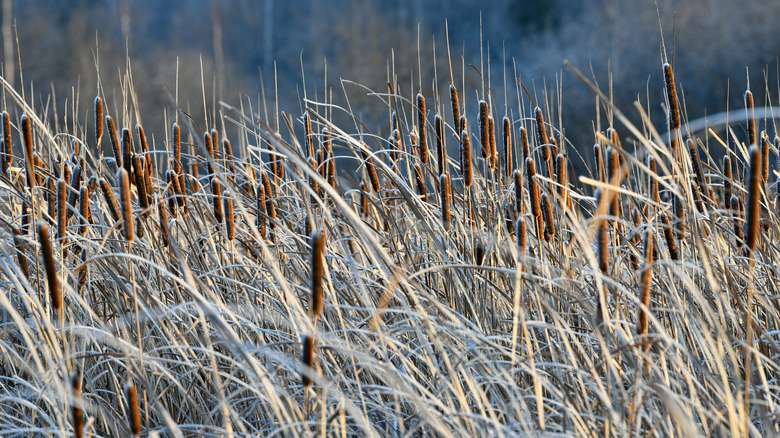How To Successfully Grow And Care For Cattail Plants
If you've ever been to a lake, pond, swamp, or other contained body of water, odds are you've come across cattail plants. The typha latifolia, also known as bulrushes or water sausages, are an extremely common, easy to care for aquatic plant. Cattails are quick growers and spread rapidly when planted, according to Gardening Know How, due to their rhizomatous roots, and are sometimes considered more of a weed than a water plant.
Cattail plants have a variety of benefits and purposes. According to Parade, cattails are a favorite among birds for both food and nesting material. They also attract small fish that birds, among other wildlife, prey on. Cattails also have a history of use among Native American communities; Native Tech lists a variety of cattail uses, including consumable, medicinal, and functional, such as making mats and floating toy ducks. Cattails can also be used industrially in the creations of solvents such as antifreeze.
Cattails are a classic, low-maintenance option for water gardens, ponds, lakes — they're even used for interior design. Read on to learn how to care for these incredibly versatile plants.
How to use cattail plants in garden
Cattail plants are most commonly seen in home landscaping lining the banks of ponds and lakes or featured in water gardens. According to Countryside, cattails are great for increasing the integrity of the land on shorelines, as well as attracting wildlife both above and below ground. Cattails also help filter out trash and other unwanted pollutants in your pond (via Magnolia Fisheries).
However, there are a few things to keep in mind when planting cattails. Their root design allows them to grow rapidly, which allows them to get out of control very easily. This growth, while annoying, can also be dangerous and compromise certain structures in your water feature, such as drains and spillways. Smaller water structures can also be completely overtaken by excess cattail growth. And, while cattails can attract desirable wildlife, they can also attract pests, including mosquitoes and snakes.
To control excess cattail growth, Cornell Cooperative Extension recommends hand-pulling unwanted plants, mowing them in the late summer, freezing the roots, or regularly applying chemical herbicides to areas you want to prevent them from growing.
How to grow cattail plants
Growing cattails is not a difficult task, but it will require some patience. You will need to begin by obtaining cattail seeds, either by purchasing them or harvesting them from mature plants. To harvest cattail seeds, SFGate says to wait until the sausage-like flower is dry, late in the summer season. Remove a few of these from the plant by simply cutting them off. Store them in a paper bag to dry out completely for a week or two, and then remove as many seeds as you can. The seeds will be a dark shade of brown — discard any white bits. Soak the seeds for a day, and prepare some starter pots for germination.
Sacred Plant Co recommends using 2 inch starter pots filled with an even mixture of sand and compost. Add one to three seeds per pot and cover with 1/4 of an inch more of your sand-compost mixture. Keep your germinations in a warm location, ideally using a heat lamp to steadily keep them at 100 degrees, spraying water on them twice a day. Maintain these conditions anywhere from two weeks to two months, and transplant them in early fall. Space them about 3 feet apart, and expect dense growth in a few years. Not only will their root system rapidly expand, but their seeds will scatter in the wind and self-germinate.
How to care for cattail plants
Cattails do not require much care, but you should make sure their needs are being met for the healthiest plant possible. Before planting cattails, ensure they'll receive ample light. According to SFGate, cattails prefer at least eight hours a day of full sun. They can survive partial shade, but The Spruce warns that they cannot tolerate full shade. If you want to plant cattails around your water feature, make sure any surrounding trees aren't blocking access to the sun. Cattails like consistent moisture, and when planted by the bank of a pond or lake, will receive plenty of water. Cattails do not need fertilizer, and due to their rapid growth rate, feeding them is not recommended.
Some may choose to grow their cattail plants in containers to contain their growth, and this comes with a separate set of care needs. When transplanting cattail germinations, make sure their new pot is at least 1 gallon, and use loamy soil for the best results (via Gardening Know How). Potted cattails will do best submerged in water, as it will allow their roots to freely grow. Potted plants also may have a tendency to produce more dead leaves, which should be cut off frequently, as should the flower heads to prevent seed germination. Feed with fertilizer specifically for water plants.
Varieties of cattail plants
Cattails come in about 30 varieties, according to Britannica. While they all generally have the same behaviors and care needs, there are slight differences, as well as physical variations. Here are just a few of the most popular varieties from Cattails.
-
Narrow leaf cattail: One of the most common varieties, this cattail grows to about 6 feet tall and sports a bright, chocolate brown flower.
-
Southern cattail: Another popular variety, this cattail can grow up to 10 feet tall and has a more yellow tint to its stalks.
-
Broadleaf cattail: This variety has a much darker, richly colored flower, and grows to 8 feet tall.
-
Dwarf cattail: This cattail variety is easily identified by its stumpy flowers, and will generally only grow up to 2 feet tall (via Garden Beast).
-
Hybrid cattail: A crossbreed between the narrow leaf and broadleaf cattail, this variety is unique for its multifaceted flower — the bottom made up of the brown tube, and the top sporting a lighter, feathery flower.
Are cattail plants toxic?
Cattail plants are not toxic. As a matter of fact, they're edible, and are popular amongst foragers and survivalists. Cattail was even ranked among one of the top 20 edible wild plants by the Farmer's Almanac. To that end, there are a variety of ways to eat cattails, according to Gardening Know How. Cattail is a popular source of starch, its use dating back to the Paleolithic era. Cattail pollen can be incorporated into many floury baked goods for an extra source of protein. Unripe, green flowers can be prepared in a number of ways: cooked and eaten like corn, battered and fried, pickled, used in soups and stews, and more. You can also eat young cattail shoots, commonly referred to as Cossack asparagus, as well as the plant's roots. Just make sure you thoroughly clean off any pond or bog residue before consumption.
When foraging for cattails, be very careful not to confuse it for iris plants, warns Survival Common Sense. Mature, un-bloomed iris plants can resemble the leaves of cattail plants, and should not be consumed. Irises are toxic, and consumption of the plant can lead to symptoms such as stomach pain, nausea, vomiting, diarrhea, burning and irritation to the mouth and throat, and burning and irritation to the skin. While most iris poisoning is mild and not life-threatening, consult a doctor if symptoms persist. A good way to distinguish the two is by the cattail's sausage-like flower.
How to repot cattail plants
Growing potted cattails is a great way to control their growth if constant herbicide application seems too daunting. While they may need more watering and attention than ground cattails, they are still low-maintenance, and many may find that not having to control in ground root expansion makes their care that much easier.
According to SFGate, cattails should only need to be repotted once every three years. To do so, begin by removing the plant from its container, then cut the rhizome roots into multiple sections. These different sections can be replanted to expand your water garden foliage, gifted, or even sold. Replant each cattail section in its own 1 gallon pot. Loam soil works best for cattail plants. According to The Spruce, loam soil refers to a ratio of soil that is roughly equal parts sand and silt with a little bit of clay; it also encourages water retention, which is ideal for cattail plants. Loam soil mixtures can be purchased, and can also be mixed to your individual needs and preferences. Loam soil is achieved by the additive of organic matter, such as peat moss, manure, dried yard waste, etc. (via Bob Vila).
